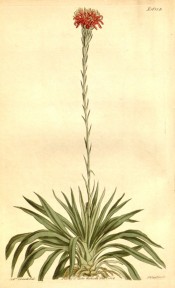Doryanthes excelsa Correa
Frost-tender perennial with erect clusters of 100 or more curving, lance-shaped leaves and, in late summer, flowering stems to 5m bearing short, lance shaped leaves and dense, spherical racemes, to 70cm across, of tubular red flowers enclosed in leafy bracts. To 6m. [RHSE, Hortus, FNSW].
Horticultural & Botanical History
‘This magnificent plant, of the liliaceous tribe, flowered last summer in the greenhouse of the Right Hon. Charles Long, at Bromley hill, in Kent; probably for the first time in Europe.’ [BM t.1685/1814].
‘Our plant, which we have had above twelve years, began to shoot up for flower in September 1821; the stem grew slowly till March 1823, when the blossoms opened, it being full twenty-five feet in height.’ [LBC no.765/1823]. Introduced to Britain in 1800. [Baker].
History at Camden Park
Listed in all published catalogues [B.108/1843]. It grows in sandstone-derived soils from Karuah, north of Newcastle to Mount Keira in the Illawarra [FNSW] and could have been easily collected by William Macarthur. Somewhat surprisingly this plant was received per ‘Sovereign’ February 1831. [MP A2948].
Notes
Published Jan 06, 2010 - 10:12 AM | Last updated Jul 16, 2010 - 05:42 PM
| Family | Doryanthaceae |
|---|---|
| Category | |
| Region of origin | Eastern Australia |
| Synonyms |
|
| Common Name | Gymea lily, Australian giant lily, Globe spear lily |
| Name in the Camden Park Record | Doryanthes excelsea |
| Confidence level | high |


